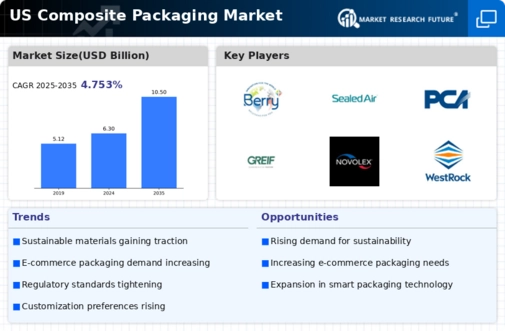Increase in E-commerce Activities
The rise of e-commerce is significantly impacting the composite packaging market, as online shopping necessitates robust and protective packaging solutions. With the increasing volume of goods being shipped directly to consumers, the demand for packaging that can withstand the rigors of transportation is paramount. In the US, e-commerce sales are projected to reach $1 trillion by 2025, which will likely drive the need for innovative composite packaging solutions that ensure product integrity during transit. Additionally, the growth of subscription services and direct-to-consumer models is further fueling this demand. Companies are increasingly seeking packaging that is not only functional but also visually appealing to enhance the unboxing experience. As e-commerce continues to expand, the composite packaging market is expected to thrive in response to these evolving consumer needs.
Growth in Food and Beverage Sector
The food and beverage sector is a significant driver of the composite packaging market, as it requires packaging solutions that ensure product safety and extend shelf life. The increasing demand for convenience foods, ready-to-eat meals, and packaged beverages is propelling the need for effective composite packaging solutions. In the US, the food packaging segment is expected to account for over 30% of the total composite packaging market by 2026. This growth is attributed to the rising consumer preference for packaged goods, which are perceived as more hygienic and convenient. Additionally, innovations in composite materials that enhance barrier properties against moisture and oxygen are likely to further boost the market. As the food and beverage industry continues to expand, The composite packaging market is poised to benefit from this trend.
Technological Innovations in Packaging
Technological advancements are playing a crucial role in shaping the composite packaging market. Innovations such as smart packaging, which incorporates sensors and indicators, are gaining traction among manufacturers. These technologies enhance product tracking and monitoring, thereby improving supply chain efficiency. In the US, the adoption of smart packaging solutions is projected to increase by approximately 20% over the next five years. Furthermore, advancements in material science are leading to the development of lighter, stronger, and more versatile composite materials. These innovations not only improve the performance of packaging but also reduce material waste, aligning with sustainability goals. As companies invest in research and development to leverage these technologies, the composite packaging market is likely to witness substantial growth driven by enhanced product offerings.
Rising Demand for Eco-Friendly Solutions
The composite packaging market is experiencing a notable shift towards eco-friendly solutions, driven by increasing consumer awareness regarding environmental sustainability. As more companies adopt sustainable practices, the demand for composite packaging materials that are recyclable or biodegradable is on the rise. In the US, the market for sustainable packaging is projected to grow at a CAGR of approximately 5.5% from 2025 to 2030. This trend is likely to encourage manufacturers to innovate and develop new composite materials that align with eco-conscious consumer preferences. Furthermore, regulatory pressures aimed at reducing plastic waste are prompting businesses to transition towards more sustainable packaging options, thereby enhancing the growth potential of the composite packaging market. Companies that prioritize sustainability in their packaging strategies may gain a competitive edge in this evolving landscape.
Regulatory Compliance and Safety Standards
Regulatory compliance and safety standards are critical drivers of the composite packaging market, particularly in industries such as food, pharmaceuticals, and cosmetics. In the US, stringent regulations regarding packaging materials and safety are compelling manufacturers to adopt compliant composite packaging solutions. The Food and Drug Administration (FDA) and other regulatory bodies impose guidelines that ensure packaging materials do not adversely affect product safety or quality. As a result, companies are increasingly investing in composite packaging that meets these regulatory requirements, which is expected to account for a significant portion of the market. Furthermore, adherence to safety standards not only protects consumers but also enhances brand reputation, thereby driving demand for compliant packaging solutions. As regulations evolve, the composite packaging market is likely to adapt, presenting opportunities for growth.





















Leave a Comment